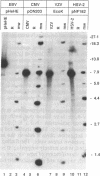Abstract
A new human herpesvirus has been isolated from CD4+ T cells purified from peripheral blood mononuclear cells of a healthy individual (RK), following incubation of the cells under conditions promoting T-cell activation. The virus could not be recovered from nonactivated cells. Cultures of lymphocytes infected with the RK virus exhibited a cytopathic effect, and electron microscopic analyses revealed a characteristic herpesvirus structure. RK virus DNA did not hybridize with large probes derived from herpes simplex virus, Epstein-Barr virus, varicella-zoster virus, and human cytomegalovirus. The genetic relatedness of the RK virus to the recently identified T-lymphotropic human herpesvirus 6 (HHV-6) was investigated by restriction enzyme analyses using 21 different enzymes and by blot hybridization analyses using 11 probes derived from two strains of HHV-6 (Z29 and U1102). Whereas the two HHV-6 strains exhibited only limited restriction enzyme polymorphism, cleavage of the RK virus DNA yielded distinct patterns. Of the 11 HHV-6 DNA probes tested, only 6 cross-hybridized with DNA fragments derived from the RK virus. Taken together, the maximal homology amounted to 31 kilobases of the 75 kilobases tested. We conclude that the RK virus is distinct from previously characterized human herpesviruses. We propose to designate it as the prototype of a new herpesvirus, the seventh human herpesvirus identified to date.
Full text
PDF
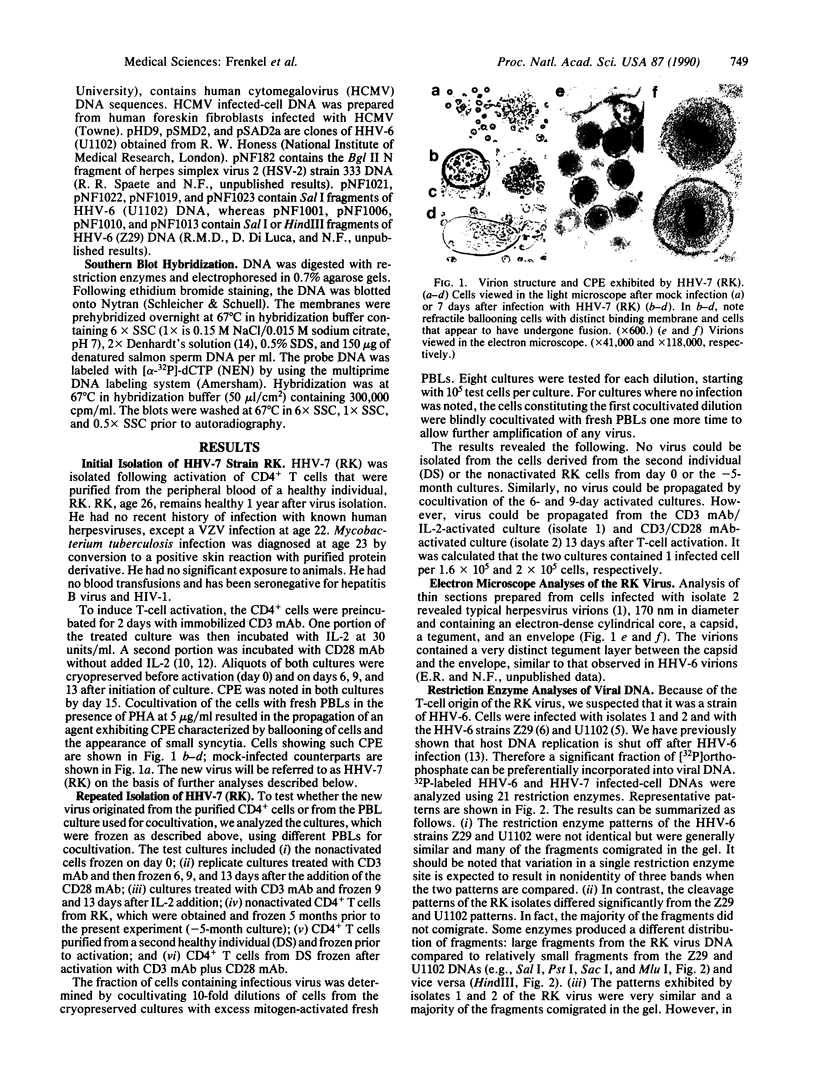
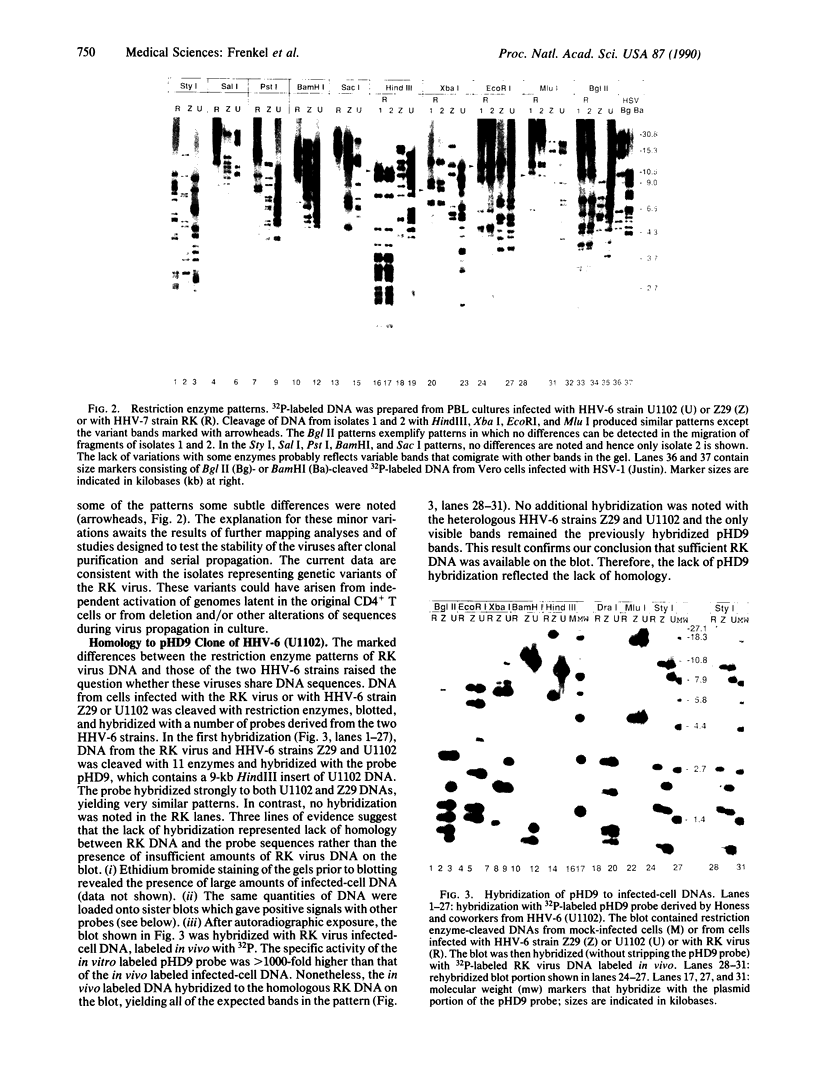
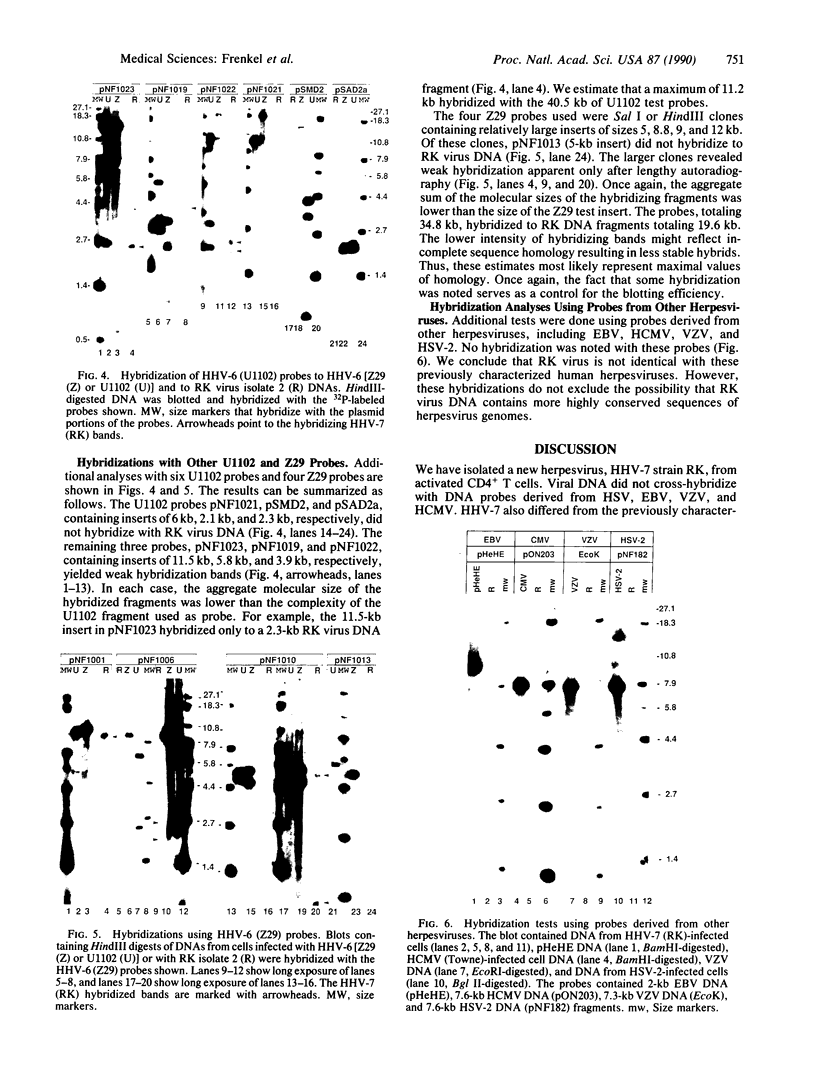
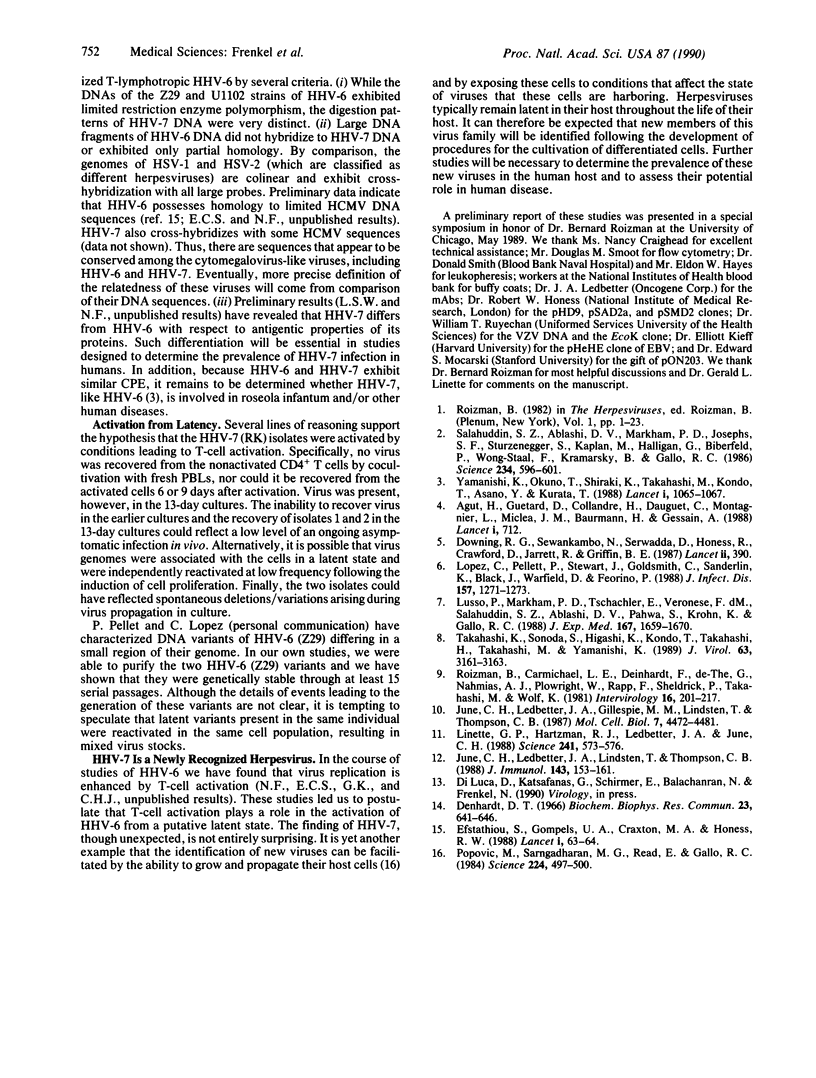
Images in this article
Selected References
These references are in PubMed. This may not be the complete list of references from this article.
- Agut H., Guetard D., Collandre H., Dauguet C., Montagnier L., Miclea J. M., Baurmann H., Gessain A. Concomitant infection by human herpesvirus 6, HTLV-I, and HIV-2. Lancet. 1988 Mar 26;1(8587):712–712. doi: 10.1016/s0140-6736(88)91520-6. [DOI] [PubMed] [Google Scholar]
- Denhardt D. T. A membrane-filter technique for the detection of complementary DNA. Biochem Biophys Res Commun. 1966 Jun 13;23(5):641–646. doi: 10.1016/0006-291x(66)90447-5. [DOI] [PubMed] [Google Scholar]
- Downing R. G., Sewankambo N., Serwadda D., Honess R., Crawford D., Jarrett R., Griffin B. E. Isolation of human lymphotropic herpesviruses from Uganda. Lancet. 1987 Aug 15;2(8555):390–390. doi: 10.1016/s0140-6736(87)92403-2. [DOI] [PubMed] [Google Scholar]
- Efstathiou S., Gompels U. A., Craxton M. A., Honess R. W., Ward K. DNA homology between a novel human herpesvirus (HHV-6) and human cytomegalovirus. Lancet. 1988 Jan 2;1(8575-6):63–64. doi: 10.1016/s0140-6736(88)91049-5. [DOI] [PubMed] [Google Scholar]
- June C. H., Ledbetter J. A., Gillespie M. M., Lindsten T., Thompson C. B. T-cell proliferation involving the CD28 pathway is associated with cyclosporine-resistant interleukin 2 gene expression. Mol Cell Biol. 1987 Dec;7(12):4472–4481. doi: 10.1128/mcb.7.12.4472. [DOI] [PMC free article] [PubMed] [Google Scholar]
- June C. H., Ledbetter J. A., Lindsten T., Thompson C. B. Evidence for the involvement of three distinct signals in the induction of IL-2 gene expression in human T lymphocytes. J Immunol. 1989 Jul 1;143(1):153–161. [PubMed] [Google Scholar]
- Linette G. P., Hartzman R. J., Ledbetter J. A., June C. H. HIV-1-infected T cells show a selective signaling defect after perturbation of CD3/antigen receptor. Science. 1988 Jul 29;241(4865):573–576. doi: 10.1126/science.2899908. [DOI] [PubMed] [Google Scholar]
- Lopez C., Pellett P., Stewart J., Goldsmith C., Sanderlin K., Black J., Warfield D., Feorino P. Characteristics of human herpesvirus-6. J Infect Dis. 1988 Jun;157(6):1271–1273. doi: 10.1093/infdis/157.6.1271. [DOI] [PubMed] [Google Scholar]
- Lusso P., Markham P. D., Tschachler E., di Marzo Veronese F., Salahuddin S. Z., Ablashi D. V., Pahwa S., Krohn K., Gallo R. C. In vitro cellular tropism of human B-lymphotropic virus (human herpesvirus-6). J Exp Med. 1988 May 1;167(5):1659–1670. doi: 10.1084/jem.167.5.1659. [DOI] [PMC free article] [PubMed] [Google Scholar]
- Popovic M., Sarngadharan M. G., Read E., Gallo R. C. Detection, isolation, and continuous production of cytopathic retroviruses (HTLV-III) from patients with AIDS and pre-AIDS. Science. 1984 May 4;224(4648):497–500. doi: 10.1126/science.6200935. [DOI] [PubMed] [Google Scholar]
- Roizman B., Carmichael L. E., Deinhardt F., de-The G., Nahmias A. J., Plowright W., Rapp F., Sheldrick P., Takahashi M., Wolf K. Herpesviridae. Definition, provisional nomenclature, and taxonomy. The Herpesvirus Study Group, the International Committee on Taxonomy of Viruses. Intervirology. 1981;16(4):201–217. doi: 10.1159/000149269. [DOI] [PubMed] [Google Scholar]
- Salahuddin S. Z., Ablashi D. V., Markham P. D., Josephs S. F., Sturzenegger S., Kaplan M., Halligan G., Biberfeld P., Wong-Staal F., Kramarsky B. Isolation of a new virus, HBLV, in patients with lymphoproliferative disorders. Science. 1986 Oct 31;234(4776):596–601. doi: 10.1126/science.2876520. [DOI] [PubMed] [Google Scholar]
- Takahashi K., Sonoda S., Higashi K., Kondo T., Takahashi H., Takahashi M., Yamanishi K. Predominant CD4 T-lymphocyte tropism of human herpesvirus 6-related virus. J Virol. 1989 Jul;63(7):3161–3163. doi: 10.1128/jvi.63.7.3161-3163.1989. [DOI] [PMC free article] [PubMed] [Google Scholar]
- Yamanishi K., Okuno T., Shiraki K., Takahashi M., Kondo T., Asano Y., Kurata T. Identification of human herpesvirus-6 as a causal agent for exanthem subitum. Lancet. 1988 May 14;1(8594):1065–1067. doi: 10.1016/s0140-6736(88)91893-4. [DOI] [PubMed] [Google Scholar]







